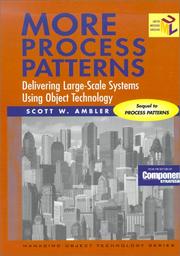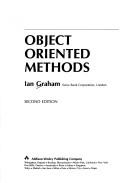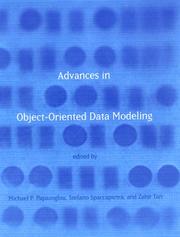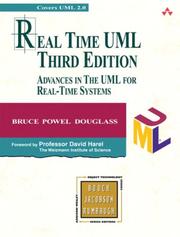| Listing 1 - 10 of 81 | << page >> |
Sort by
|
Book
ISBN: 0769533736 1509084207 Year: 2008 Publisher: [Place of publication not identified] IEEE Computer Society
Abstract | Keywords | Export | Availability | Bookmark
 Loading...
Loading...Choose an application
- Reference Manager
- EndNote
- RefWorks (Direct export to RefWorks)
Object-oriented methods (Computer science) --- Electronic data processing --- Engineering & Applied Sciences --- Computer Science --- Object development methods (Computer science) --- Object orientation (Computer science) --- Object-oriented development (Computer science) --- Object technology (Computer science) --- System design --- Distributed processing
Book
ISBN: 1282258079 9786612258077 0080958796 0123749425 Year: 2007 Publisher: Amsterdam, [Netherlands] : Morgan Kaufmann Publishers,
Abstract | Keywords | Export | Availability | Bookmark
 Loading...
Loading...Choose an application
- Reference Manager
- EndNote
- RefWorks (Direct export to RefWorks)
Until recently, all of the interactions between objects in virtual 3D worlds have been based on calculations performed using linear algebra. Linear algebra relies heavily on coordinates, however, which can make many geometric programming tasks very specific and complex-often a lot of effort is required to bring about even modest performance enhancements. Although linear algebra is an efficient way to specify low-level computations, it is not a suitable high-level language for geometric programming. Geometric Algebra for Computer Science presents a compelling alternative to the limit
Geometry, Algebraic. --- Computer science --- Object-oriented methods (Computer science) --- Mathematics. --- Object development methods (Computer science) --- Object orientation (Computer science) --- Object-oriented development (Computer science) --- Object technology (Computer science) --- System design --- Computer mathematics --- Electronic data processing --- Mathematics --- Algebraic geometry --- Geometry
Book
ISBN: 1538641410 1538641429 Year: 2018 Publisher: Piscataway, New Jersey : Institute of Electrical and Electronics Engineers,
Abstract | Keywords | Export | Availability | Bookmark
 Loading...
Loading...Choose an application
- Reference Manager
- EndNote
- RefWorks (Direct export to RefWorks)
Distributed databases --- Object-oriented methods (Computer science) --- Electronic data processing --- Distributed processing --- Object development methods (Computer science) --- Object orientation (Computer science) --- Object-oriented development (Computer science) --- Object technology (Computer science) --- System design

ISBN: 0511584997 0511001711 9780511001710 0521652626 9780511584992 Year: 1999 Publisher: Cambridge : Cambridge University Press,
Abstract | Keywords | Export | Availability | Bookmark
 Loading...
Loading...Choose an application
- Reference Manager
- EndNote
- RefWorks (Direct export to RefWorks)
With his new book, More Process Patterns, Scott Ambler picks up where Process Patterns left off. In this book, the author presents process patterns for the second half of the development lifecycle. He covers the Deliver phase and the Maintain and Support phase of large-scale, object-oriented system development. Each presented pattern is based upon proven, real-world techniques and is geared toward medium to large-size organizations who need to develop software internally to support their main line of business. The book covers major management issues, such as people and risk management, and quality assurance. Developers and project managers who have just taken their first OO development course will find this book essential. It takes the true needs of software development and delivery into consideration, including cross-project, maintenance, operations, and support issues. This book uses the Unified Modeling Language (UML).
Object-oriented methods (Computer science) --- Computer software --- Development of computer software --- Software development --- Object development methods (Computer science) --- Object orientation (Computer science) --- Object-oriented development (Computer science) --- Object technology (Computer science) --- System design --- Development.
Book
ISBN: 0429079672 1280031964 0203212398 1482268051 9786610031962 9780203212394 100068718X Year: 1999 Publisher: London ; Bristol, Pa. : Taylor & Francis,
Abstract | Keywords | Export | Availability | Bookmark
 Loading...
Loading...Choose an application
- Reference Manager
- EndNote
- RefWorks (Direct export to RefWorks)
There has been an increasing demand in GIS for systems that support historical data: time-series data as well as mobility information. From a modelling perspective, there are advantages in integrating object-oriented analysis and design to databases as well as to visualisation capabilities of GIS.Object-Oriented Design for Temporal GIS explores the major components of the object-oriented analysis and design methods, how they can be used for modelling spatio-temporal data, and how these components are developed and maintained within a GIS. It also offers practical guidance to object-oriente
Geographic information systems. --- Object-oriented methods (Computer science) --- Object development methods (Computer science) --- Object orientation (Computer science) --- Object-oriented development (Computer science) --- Object technology (Computer science) --- System design --- Geographical information systems --- GIS (Information systems) --- Information storage and retrieval systems --- Geography

ISBN: 0201593718 9780201593716 Year: 1994 Publisher: Reading (Mass.): Addison-Wesley
Abstract | Keywords | Export | Availability | Bookmark
 Loading...
Loading...Choose an application
- Reference Manager
- EndNote
- RefWorks (Direct export to RefWorks)
Programming --- Object-oriented methods (Computer science) --- Object-oriented databases --- Object-oriented programming (Computer science) --- 681.3*D15 --- Object development methods (Computer science) --- Object orientation (Computer science) --- Object-oriented development (Computer science) --- Object technology (Computer science) --- System design --- Software: object-oriented programming --- 681.3*D15 Software: object-oriented programming

ISBN: 0201309947 Year: 1998 Publisher: Reading (Mass.): Addison-Wesley
Abstract | Keywords | Export | Availability | Bookmark
 Loading...
Loading...Choose an application
- Reference Manager
- EndNote
- RefWorks (Direct export to RefWorks)
Computer. Automation --- 681.3*H2 --- Object-oriented methods (Computer science) --- Object development methods (Computer science) --- Object orientation (Computer science) --- Object-oriented development (Computer science) --- Object technology (Computer science) --- System design --- Database management: security; integrity; protection--See also {?681.5*E5} --- 681.3*H2 Database management: security; integrity; protection--See also {?681.5*E5}

ISBN: 0672318121 9780672318122 Year: 2002 Publisher: Indianapolis Sams
Abstract | Keywords | Export | Availability | Bookmark
 Loading...
Loading...Choose an application
- Reference Manager
- EndNote
- RefWorks (Direct export to RefWorks)
Programming --- programmeertalen --- Java (informatica) --- C++ (informatica) --- CORBA (common object request broker architecture) --- Object-oriented methods (Computer science) --- CORBA (Computer architecture) --- Common Object Request Broker Architecture (Computer architecture) --- Computer architecture --- Middleware --- Object development methods (Computer science) --- Object orientation (Computer science) --- Object-oriented development (Computer science) --- Object technology (Computer science) --- System design

ISBN: 026228121X 0585443920 9780262281218 9780262161893 9780585443928 0262161893 Year: 2000 Publisher: Cambridge, Mass. MIT Press
Abstract | Keywords | Export | Availability | Bookmark
 Loading...
Loading...Choose an application
- Reference Manager
- EndNote
- RefWorks (Direct export to RefWorks)
Until recently, information systems have been designed around different business functions, such as accounts payable and inventory control. Object-oriented modeling, in contrast, structures systems around the data--the objects--that make up the various business functions. Because information about a particular function is limited to one place--to the object--the system is shielded from the effects of change. Object-oriented modeling also promotes better understanding of requirements, clear designs, and more easily maintainable systems.This book focuses on recent developments in representational and processing aspects of complex data-intensive applications. The chapters cover "hot" topics such as application behavior and consistency, reverse engineering, interoperability and collaboration between objects, and work-flow modeling. Each chapter contains a review of its subject, followed by object-oriented modeling techniques and methodologies that can be applied to real-life applications.Contributors : F. Casati, S. Ceri, R. Cicchetti, L. M. L. Delcambre, E. F. Ecklund, D. W. Embley, G. Engels, J. M. Gagnon, R. Godin, M. Gogolla, L. Groenewegen, G. S. Jensen, G. Kappel, B. J. Krm̃er, S. W. Liddle, R. Missaoui, M. Norrie, M. P. Papazoglou, C. Parent, B. Perniei, P. Poncelet, G. Pozzi, M. Schreft, R. T. Snodgrass, S. Spaccapietra, M. Stumptner, M. Teisseire, W. J. van den Heuevel, S. N. Woodfield.
Engineering & Applied Sciences --- Computer Science --- Object-oriented methods (Computer science) --- Computer software --- Development. --- COMPUTER SCIENCE/General --- Development of computer software --- Software development --- Object development methods (Computer science) --- Object orientation (Computer science) --- Object-oriented development (Computer science) --- Object technology (Computer science) --- System design --- Méthode orientée object (Informatique) --- Logiciels --- Development --- Développement --- Object-oriented methods (Computer science).

ISBN: 0321160762 Year: 2004 Publisher: Boston Addison-Wesley
Abstract | Keywords | Export | Availability | Bookmark
 Loading...
Loading...Choose an application
- Reference Manager
- EndNote
- RefWorks (Direct export to RefWorks)
Embedded computer systems --- Real-time data processing. --- Object-oriented methods (Computer science) --- Systèmes enfouis (Informatique) --- Temps réel --- Méthode orientée object (Informatique) --- Programming. --- Programmation --- Object-oriented methods (Computer science). --- Real-time data processing --- Fast-response data processing --- High-speed data processing --- Electronic data processing --- Object development methods (Computer science) --- Object orientation (Computer science) --- Object-oriented development (Computer science) --- Object technology (Computer science) --- System design --- Programming
| Listing 1 - 10 of 81 | << page >> |
Sort by
|

 Search
Search Feedback
Feedback About
About Help
Help News
News